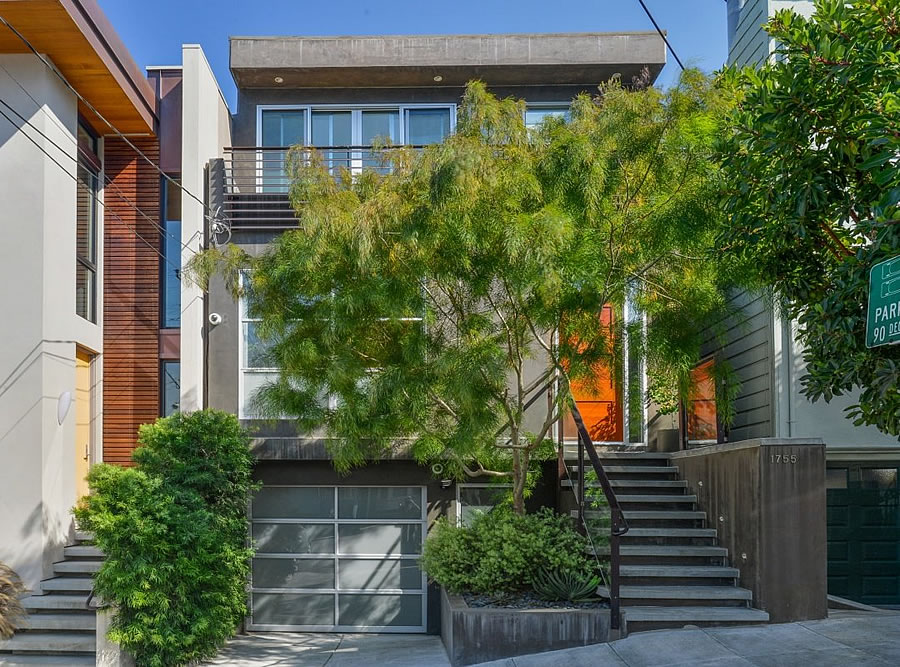Having averaged annual appreciation of roughly 14 percent a year from 2012 to 2015, at which point it traded hands for $2.325 million or roughly $1,091 per square foot, the contemporary Bernal Heights home at 1755 Alabama Street returned to the market listed for $2.495 million last month.
In contract within a week, the sale of 1755 Alabama Street closed escrow yesterday with a reported contract price of $2.6 million or roughly $1,220 per square foot, representing total appreciation of 11.8 percent over the past 28 months on an apples-to-apples basis or roughly 5.0 percent per year.








Up 12% since that so-called 2015 “peak.” Almost exactly in line with the case shiller index (up 13%). In other words, 2015 was not the peak, nor was 2014 or 2016. But, it is true that gains were even stronger from 2012-2015. “Appreciation Has Slowed But Remains Solid” may not be a catchy story line, although it would be accurate. This place was in contract in 6 days and closed in 31 days, which is pretty telling of the state of the market.
As expected, it’s nice of you to chime in now that it’s sold and you know the outcome. But of course, this one was “cherry picked” and doesn’t count, just like all the others which tell a more complex story that you consistently to choose to confuse or ignore.
“all the others” is a highly inaccurate way to put it. “The others that socketsite cherry-picked” would be accurate. I’ve oft-noted it would be fine it you listed all recent “apples to apples” sales. But you don’t even attempt to pick a representative sample. Nevertheless, kudos for highlighting one that actually represents the market as a whole, as demonstrated by the case shiller index.
As to your attempt at criticism: how would you expect a person to chime in on the outcome before there has been an outcome?
As we wrote at the time, and to which others somehow managed to adhere: “If you think you know the market in Bernal Heights, now is the time to tell or forfeit the right to type “I told you so” or whine about “cherry picking” or anecdotes.”
And of course, the Case-Shiller Index is for the Bay Area market as a whole, not simply San Francisco. But there are measures for the strength of the market in SF proper and even an index specific to new construction sales and pricing.
I can’t say I understand your point. I said nothing even resembling “I told you so” or “cherry picking” or “anecdotes.” You’re the one that mentioned cherry-picking, and I offered kudos for not doing so with this particular post.
In that case, we’re looking forward to your equally enthusiastic kudos with respect to our reports on the apples-to-apples sales of the remodeled single-family homes at 948 Hampshire (Mission), 864 Florida (Mission) and 538 28th Street (Noe) as well, assuming they sell.
And just to be clear, the outcome of each will be equally as representative of their respective segments of the market in San Francisco (versus the Bay Area as a whole), as will the loft sales on Bryant and 4th Street, correct?
“the outcome of each will be equally as representative”?
That’s really not hard to ascertain. If their gain is more than the case shiller index, they have outperformed the market generally. If their gain is less than the case shiller index, they have underperformed the market generally. Not really complicated. In this example at 1755 Alabama, it happened to be just about right in line with the market with a 12% gain since mid-2015. And pretty close to your linked “measure for the strength of the market in SF proper” which showed a 10% year-to-year gain in SF.
We admire your consistency in purposefully confusing an index for the greater Bay Area with San Francisco proper and movements in the median price with actual values; an uncanny inability to segment the market; and the fortitude to selectively, and rather ironically, claim “cherry picking” whenever the data doesn’t fit your model.
And with that, we wish you the best of luck but no longer take you seriously, not even as a foil.
Now back to the topic at hand…
Now you’re just being odd. You posted a link that you described as a “measure for the strength of the market in SF proper.” All I did was point out that the linked post stated SF prices were up 10% in the last year. Then you offer up a criticism that I’m “confusing . . . movements in the median price with actual values.” That was your link and your description.
Look, I know that you really, really want to pretend that SF is totally different from SF plus a couple of close neighbors as that way you can pretend the widely accepted case shiller index just doesn’t apply at all. And I know you really, really want to pretend that prices have fallen here because you made that “call” about 18 months ago, and it turns out to have been completely wrong. But facts are facts. Prices continue to rise in SF. Doesn’t mean they will forever, or even tomorrow, but that is the fact of the last couple years and the three years before that. Your call was wrong then and it remains wrong today.
[Editor’s Note: To be clear, our call was for the new condo market. But hey, what do we know (above and beyond being able to segment the market).]
“how would you expect a person to chime in on the outcome before there has been an outcome?”
But that’s the point. Many of the properties featured here are featured when they are listed (or even had been featured during their prior sale). So, how is it cherry picking before there’s even been an outcome?
SS: You should not, in my opinion, argue with your readers, it’s bad form and bad journalism.
I strongly disagree. SocketSite’s snarky rejoinders to poor arguments are the second-best thing in this site (the best being the original articles).
I agree. From what I recall from my reading, Socketsite did not do this until recently. It is unbecoming.
We’ve always taken people to task for purposefully misrepresenting data and have no qualms about challenging misinformation, especially when it comes to our past reports. And now back to 1755 Alabama, Bernal Heights or even the market for single-family homes…
A drop from 14% per year to 5% per year is already a very significant deceleration. And it’s likely that the recent 11% appreciation over 28 months was front loaded.
Only you are flogging the straw man that the market has already crashed. If you look at the last cycle there was about 18 months of relative flatness at the top before the decline began in earnest.
There are good reasons to look to the condo market for early indicators of a market change. There’s often less emotion and a more professional thinking with regards to opportunity costs/time value of money and market cycles in that market segment.
Many argued during the last cycle that SFR’s would “decouple” and only condo’s would decline. That didn’t happen. You have substitution effects between condo’s and SFRs. And the key dynamic of momentum is the same for both.
When houses like this one were rising at 14% per year, they were “affordable” to many many people. Flattening out at $2.6 is a very much different story
You are right – prices rising 5% a year is not as strong as prices rising 14% a year! But it is still appreciation at a decent clip. Puts the lie to the “market peaked in 2015” line that is very often repeated here (or “down 20%”!!! that has been posted numerous times).
OMG, this statement is so wrong on so many levels, here is why:
1) “And it’s likely that the recent 11% appreciation over 28 months was front loaded.”
Show me any figures that indicate that 2016 single family home appreciation in SF was stronger than 2017. The 11% appreciation of 28months is most certainly back-loaded.
2) “If you look at the last cycle there was about 18 months of relative flatness at the top before the decline began in earnest.”
Great, if flattening of the market is a good early indicator of a decline, I’m sure you have been paying attention to other leading indicators like e.g. inventory. Has inventory started increasing like the last time the market flattened?
3) “You have substitution effects between condo’s and SFRs. And the key dynamic of momentum is the same for both.”
Where to start? Firstly, condos tend to be 0-2 bedroom units while SFRs are 2-4 bedroom units. How many families have you seen selling their SFR and moving into a 1 bedroom apartment because the condo prices have decreased slightly?
Secondly, if 5000 new housing unites were created in 2017, how many are condos and how many are SFH? I would argue that new SFHs are less than 100. This shows you that the supply of condos is flexible while the supply of SFH are pretty fixed. This explains the stronger appreciation of SFH over the past 2-3 years.
Both these arguments suggest very strongly that there is very little substitution between condos and SFH and the market dynamics are very different for the two.
4) “When houses like this one were rising at 14% per year, they were “affordable” to many many people. Flattening out at $2.6 is a very much different story”
Affordability is a function of income. While the price of $2.6M is mind-bogglingly high, there are enough people in SF who can afford it. While it is hard to believe, growth in income has outpaced the growth in rents over the past few years in SF. This is due to the strong inflow of high earners.
1) Since you and your compatriots seem to be hanging your hat on the wider case-shiller numbers. Look at the Case-Shiller graph for 2016. Where do you see this flattening in 2016? Meanwhile, more recently even the wide area index has started to slip (“the S&P CoreLogic Case-Shiller Index for single-family home values within the San Francisco Metropolitan Area – which includes the East Bay, North Bay and Peninsula – slipped 0.1 percent in August”).
2) Some people are arguing that it will be a boom-flat cycle this time, not a boom-flat-bust cycle. I find this very unlikely since it runs counter to many previous housing market cycles and due to the stark economic difference between buying in a strongly rising market vs buying and holding at a high & flat-lining price.
And I think demand or lack thereof is going to be more salient in this cycle. The 2007 bubble didn’t burst because there were suddenly too many houses.
This would be a better leading indicator to watch (“…which is over three times the typical seasonal decline. And on a year-over-year basis, sales were down 32.5 percent, which is the largest year-over-year drop since 2009, according to recorded sales data from CoreLogic”).
3) Do I know many families who are in or want to buy condos? Yes. Prop 13, high transaction costs and market uncertainty makes it less likely for people to jump around in the market. But substitution just means that there are many who are considering both condoss and SFRs and look at the relative prices of the two categories. Many low end SFRs are in marginal areas, have poor layouts and many professionals would rather pay a single HOA than deal with a-la-carte home maintenance. Your second point does not show that buyers can’t substitute between the two.
4) I’m not sure who looks at income to rent ratios, but price-to-rent ratios have been shooting up just like the 2007 cycle.
Affordability is very much tied to home price appreciation/depreciation. Nearly anyone can cash a check for an appreciated home, but to hold on to property at a stretched price-income ratio without appreciation (and with high transaction costs) is very different. And when even a slight downward tilt of the market occurs, losing a few percent of $2.6M quickly adds up.
1) Look at an SF-only chart. I would post a link here but it would go against the terms of socketsite. The market flattened through 2016 for SF SFH and gained +10% in 2017.
2) You mention the right data (32.5% drop in sales y-on-y) but you are making the wrong conclusion. The sales are falling BECAUSE OF FALLING INVENTORY, not because of falling demand. You can see this in plenty of inventory data and it is the only way to explain rising prices when overall transactions are falling. If lower demand would be the driver of falling sales, prices would be falling too.
3) once you have a family of 4, you don’t move into a 1 bedroom in SF because you can’t afford a house, you move out to Concord, Stockton or Sacramento where you can afford the space. There are very few 3-4 bedroom condos in SF that offer a valid substitute for SFH. Also, most of the newly constructed housing are0-2 bedroom units that target single tech workers, not families with kids. This leads to a situation where the supply of housing for families remains unchanged, while more wealthy families move to the city. The result is price appreciation for SFH that decouples from condo prices.
4) there is a study on rental affordability for apartments in US metro areas that shows how wage increases outpaced rent increases in SF over the past 2 years. Google it
The Dow is up around 25% since 365 days ago. I doubt this will continue the next 365 days but then again who knows. RE is usually slow and steady when compared to the stock market and they both are influenced by and influence general economic conditions.
I was pretty close.
There is a more simple explanation for this.
1) For single family homes, appreciation of the luxury market segment (e.g. >$2.0MM) has slowed, whereas the middle market (around 1MM – 2MM) and the bottom segment (<1MM) keep on rising at a pace comparable to the 2015. As Socketsite's apples-to-apples comparison focuses primarily on luxury homes and condos, it produces examples of limited market appreciation. It would be really nice to see a few more apples-to-apples comparisons for single family homes of below $2MM and below $1MM.
2) The market moved sidewise in 2016 while increasing around 10% in 2017. Yes, it is accurate that this boils down to a compounded annual growth rate of around 5%, but the current market trend is a strong price appreciation driven by strong demand and a drop in supply (record low inventory).
That summary is pretty spot on.
Spot on?
“The market moved sidewise in 2016”
“Look at an SF-only chart.”
“Look, I know that you really, really want to pretend that SF is totally different from SF plus a couple of close neighbors as that way you can pretend the widely accepted case shiller index just doesn’t apply at all. ”
You’ve spent months here beating the drum that the SF specific new condo data and SF apples are deceptive/invalid because they didn’t move in lock step with the wider bay area case-shiller index. But now you’re on board with the idea that during 2016 SF proper decoupled from the wider case-shiller and flattened out?
No, the case shiller index shows things flattening the second half of 2016 then rising again in 2017. (not falling, or crashing as some postings stated). No “decoupling.” SF-only is no different from SF plus a few immediate neighboring counties.
More relevant though as the holding period of this property includes the entirety of 2016 is the 5% YoY gain for 2016.
And if there’s no decoupling, what’s so wrong about looking at early signs of weakness in some segments as presaging whats to come for the wider market? Or will SF condos decouple downwards while SF SFR’s are tied to the wider market?
If you look at the 2007 cycle, you’ll see different segments had different timings and magnitudes, but ultimately followed the same path.
So one one hand, the idea that SFRs (or any other segment) will decouple and not follow the rest of the market down in a cycle seems unlikely, but conversely trying to “disprove” data points you don’t like by comparing them percent for percent to one of wider metrics seems futile.
On a year-over-year basis, the Case-Shiller Index was actually up an average of 5.9 percent in the second half of 2016. And in the first half of 2017, it was up an average of 5.9 percent as well.
Cutting the data another way while attempting to side-step any seasonality when comparing a first to second half of two years, the index gained a total of 5.5 percent in the first eight months of 2016 while the index has gained 5.4 percent in the first eight months of 2017.
Okay, so accepting these serious attempts at statistical gymnastics, the conclusion is the market rose in 2016 and continued to rise in 2017. And that supports the argument that the SF market went down because . . . . oh, I guess not.
I don’t care. Flattened in 2016 then continued up. Or continued up throughout 2016 and 2017. Either way. My point has always been simply there has been no downturn in SF as of yet, despite the posts of “down 20%!!!” and “look at this SOMA condo below 2015!!!” Sounds like we’re in agreement on the primary point.
Here is my point:
1) I believe SF SFH prices remained relatively flat in 2016 and rose significantly in 2017. This does not necessarily stand in opposition to the SF BAY AREA Case Shiller index seeing equal sized price increases in 2016 and 2017 FOR THE ENTIRE REGION. If you can present me with some new evidence for SF SFHs that supports your thesis, I’m happy to change my point of view on this.
2) Regarding SF condos and SF SFHs prices, I would really like to hear your take on the supply dynamics (inventory) of the two. Between 2010 and 2015, 9’991 new units were constructed in SF. Of these, only 90 (=1%) were SFHs. (page 23/75). This means that while condo supply increases over time, SFH supply remains flat. Further, the majority of condos constructed are smaller in size (0-2 bedrooms) while SFHs are larger (2+ bedrooms). I don’t have a link for this, but I believe it is commonly understood to be the case. Now, if you accept the two premises above, you should expect different price dynamics for condos and SFH over time. Again, if you have any data going against this thesis, I’m very happy to consider it.
‘anon’ and you have been prone to trying to discredit actual apples-to-apples or new condo sales/pricing data by referencing the wider (and a few months delayed) Case-Shiller numbers and refusing to see that different segments can have different timings. But now you want it both ways by floating a theory that SF SFR’s diverged from the wider BA in 2016.
When you have few years averaging 14% growth going to a few averaging 5% I think it’s most likely that the actual trend was some curve starting at over 14% dropping to under 5%. Given that this property is only one data point, I’m not sure how much accuracy you could hope for, but I think the above assumption is most likely. If you’re making a case that the appreciation was 0% then 10%, the burden of proof is on you for that.
For #2, look at the case-shiller graph for the 2007 era. Did SFR’s boom-flat then while condo’s boom-flat-busted? SF has the lowest percentage of children of any large city and it’s been this way for a while. Most families leave because of schools, crime and grime. If the demand was there for larger units they would get built. And many lower end SFR’s are not all that attractive to families.
Anon2, again, you’re avoiding the question about falling SFH inventory in San Francisco.
First off, you haven’t provided any of this inventory data.
Secondly, I think this cycle is demand driven. Did the 2007 bubble burst because of a surge in inventory?
Thirdly, doesn’t your argument about increased condo construction apply back in 2007? And yet SFR prices still fell.
Fourthly, you point to demand by larger families, but this is not a large part of the SF market.
Fifthly, I’m not sure the family/non-family breakdown lies cleanly with the SFR/condo distinction as you seem to think.
Sixthly, it’s well known that housing prices have some stickiness on the down-side as some sellers, rationally or not, may hold out for some reserve price they have in their heads. So it would not at all be unexpected for weakening prices to cause short term reductions in inventory as sellers hold off for “better market conditions”. That’s one reason to look to new-condo numbers as leading indicators as those sellers are more professional/less emotional. And I do think that on average SFR owners are towards the other end of the scale, less likely to be professionals and more emotionally attached.
2007 is not when the SF market shift occurred.
That’s true. But in fact, while most of the northern neighborhoods didn’t start getting hit until 2008, the shift actually started in mid-2006, which was the previous peak for the southern neighborhoods, and was already spreading north in 2007, catching those who misread the early signs completely off guard.
Here is a good and recent article on the fall in housing inventory and the rise in housing prices over the same time.
1. Why are houses only 10-15 days on the market before being snapped up?
2. Why has inventory fallen 27-50% across the region?
3. Why are prices up 10-15% compared to last year?
If I recall correctly, in 2007, prices flattened, market inventory started increasing, days-on-market started increasing, then prices fell. but today, we’re seeing quite different condition.
“The San Jose metropolitan area posted the nation’s steepest year-over-year plunge in the number of homes for sale in October — falling by a precipitous 51.6 percent.”
You’re trying to make a case that SF SFR’s will decouple when the article is talking about San Jose metro area? And in the second paragraph the article uses medians which aren’t a good measure of prices.
Then even worse it uses “over asking” as a measure of market strength (Mixing SFRs and condos even): “The Redfin report also ranks the Bay Area’s three main metro areas as the most competitive markets in the U.S. Combining data for single-family homes, condominiums and townhouses, it ranks San Francisco as the nation’s most competitive market, with 78.6 percent of homes selling for above the list price in October.” Then uses DOM, which is also commonly manipulated. And even lists Seattle is the top in speed of sale.
Finally they say this: “Thursday in all of Santa Clara County, Swartz pointed out, only 620 single-family homes were on the market. Adding condominiums and townhouses to the mix, the total still only grew to 745 listings.”
So if you subtract out that gives you 620 SFR’s and only 125 condos. So that puts the SFR inventory at 5x that of condos. So, No, Looking at unreliable stats from San Jose where SFR’s outnumber condos by 5x does not prove your point.
Take note “SoBayNative” from the other thread! People do quote and use “over asking” and DOM stats in articles and people do get fooled by them.
I mean, if you’re going to just google something and throw it out there, it might as well be something relevant. For example: What drives condo prices : the rental or single family housing market?
“The results of the analysis tell us that condo prices have followed and acted very much like single family home prices during the last 16 years.”
Granted, I’ve never heard of this guy, but looking at correlations between two price series should be well within the capabilities of a MIT Econ PhD and far more relevant then some scattershot newspaper article.
Socketsite, your “catching those who misread the early signs completely off guard” link is very funny. Summer 2008 was when my wife first started telling me we should think about moving, and I told her no way I was buying with the market cratering. Thank for those memories! (she eventually admitted I had been right)
By June 2008, the SF case shiller numbers showed the market had fallen a lot, down 27% over the prior two years. But many were arguing, “not in SF because look at this one anecdote, etc.” Like in the thread you linked. Today we have the same exact logical flaws but in the other direction. Case shiller SF data clearly show prices holding up and rising a little, yet we see many arguing, “not in SF because look at this one anecdote, etc.” History repeating itself, but in a mirror. You want a solid picture of the market without spin? Just look at case shiller. Anyone tries to argue that doesn’t apply to SF has a heavy burden of proof, and I’ve yet to see anyone come close to satisfying it.
Different markets/drivers, different patterns (bottom-up versus top-down) but plenty of the same mistakes in ignoring apples-to-apples sales and demand data in favor of broader indexes or movements in the median sale price (the moving average for which didn’t peak until mid-2008 in San Francisco despite the market having started to shift two years prior).
Call it “2007-era cycle” if you want. My point wasn’t to refer to an exact point when the market dropped, but to refer to a particular market cycle.
Again, look at the spread between the three case-shiller price tiers during at the top and bottom of the last cycle. And do you think that the low tier (Under $660k at first sale) is evenly distributed between SF proper and surrounding areas?
So, yes, there is evidence that all market segments don’t move in exact lock step during market cycles. But yet all three tiers and the condo index did eventually follow the same up-flat-down cycle. The truth lies between an exact tracking of all segments and a complete decoupling of some favored segment (SFRs, SF proper, “prime” SF, High end,….)
anon2,
You clearly didn’t finish reading even the sentence you were quoting: San Jose’s 51.6 percent year-over-year tumble in the number of homes for sale was unmatched, though San Francisco had the second steepest decline in the U.S., 28.5 percent.
How do you explain the 28.5% drop in inventory in San Francisco.
And although people like debate if a market transitioned at 10:23am Sept 23, 2018 vs 10:55am Sept 23, 2018, or if something has changed 5% vs 7% you have to wonder if that level of precision is useful or even possible.
I see the linked comment: “San Francisco never really took a price hit and it won’t, either. ” and I can’t even begin to tell you how many times I’ve heard some variation of that sentiment even though it is demonstrably false. That type of sentiment is a key factor in bubble psychology. How do you expect people will behave if they believe there is no price downside??
You’re trying to prove that SF SFR’s will decouple from the rest of the region and/or did decouple throughout 2016 by pointing out that SJ had about 2x the percentage drop in inventory YoY in Nov 2017? And no breakdown there between SFR and condo inventory? There’s no there there.
“completely off guard” ? naah. Did some terrific business actually.
And while the backward looking part of the “San Francisco never really took a price hit and it won’t, either.” is simply false, looking at the date of the post the prediction was, shall we say, “Ill timed” at the very least. It’s hard not to draw a parallel to anon’s line in the sand that ‘anyone looking to get under 2016 prices will be sorely disappointed’
Taking a long view over the past 15-16 years, fall 2008 to 2011 is the blip, isn’t it?
One more time anon2: How do you explain the 28.5% drop in inventory in San Francisco from 2016 to 2017?
‘anyone looking to get under 2016 prices will be sorely disappointed’
Absolutely true statement. You’re re-writing this to mean “anyone looking to get under 2016 prices at any time in the future will be sorely disappointed” – not what I ever said nor what I ever meant. SF prices could crash tomorrow for all I know. All I’ve ever pointed out is that — to date — prices have not fallen, and in fact they have continued to rise, modestly in the last couple of years. This is to counter the false drumbeat of “down 20%!!!” and “selling below 2015!!!” that is oft-repeated here in citing to either cherry-picked anecdotes or, often, to nothing other than “someone else said so.” And the editor conveniently deletes posts I’ve made citing “apples” with pretty significant gains in recent years. Again, if all recent re-sale “apples” were cited, there’d be no beef. Cherry-picked anecdotes are worthless. Case shiller has been an extremely reliable SF market indicator, which is why it is necessary to undertake all sorts of mental gymnastics to try to distance oneself from it (“decoupling SFRs,” hypothetical “changes in mix,” “ignoring demand data” and nonsense like that).
[Editor’s Note: While we’ve given ‘anon’ a rather wide berth when it comes to being relevant, we did remove or flag a total of two of anon’s cherry-picked anecdotes.
One in which ‘anon’ deftly countered an apples-to-apples sale of a South of Market loft, which disappointingly sold for less than its 2015 price, with the performance of an Inner Mission cottage (the arm’s length sale of which we couldn’t verify).
The second, in which ‘anon’ deftly parried the latest price cut for a modern $5.5 million Noe Valley home, which remains active and available, with the sale of $1.6 million Victorian condo in NoPa.]
I don’t see how ‘explaining’ that would prove your point in any way, but I will say that I’ve repeatedly said here that some types of owners, owner occupiers, would be initially prone to responding to price weakness by holding their inventory off market. While others, professional sellers, would be more motivated to cut price and move product. So, generally I would not see a fall in inventory as inconsistent with a deceleration of prices.
Here’s another hint. Guess what happens when the volume of move-up buyers, along with turnover, slows down?
“Guess what happens when the volume of move-up buyers and turnover slows down?”
Pretty easy one. Depends. If the cause of the reduced volume is low supply (with demand remaining level), the answer is: prices rise. If the cause of the reduced volume is low demand (with supply remaining level), the answer is: prices fall.
That’s why the low supply numbers to which pero keeps referring are critical. SF in 2017 has been marked by very low supply. Because demand has remained high, prices have risen.
Ok, here is my position on this. If real estate slows down, this can be a sign for two very different price dynamics:
1) It could be due to falling demand. In this case, we should see increasing inventory and falling prices (as less buyers chase the same amount of houses for sale). Prices might initially be sticky, but the build up of inventory is usually an indicator for soon-to-be falling prices. This is what happened in 2007.
2) It could be due to falling supply. In this case, we should see a drop in inventory and an increasing prices (as the same amount of buyers are chasing less houses for sale). The data in the Mercury News and the Socketsite article point strongly to this scenario (I don’t see where you find ‘initial price weakness’ in this market).
In conclusion, a drop in sale volume by itself does not tell you anything about the state of the market. It is the drop in sale volume, combined with the move in inventory, combined with the move in prices that gives you the full picture about the supply-demand dynamics of the market.
Here’s where that old supply stat (new listings added to the MLS), which has frequently been misreported as inventory (active listings, which is a function of sales), might actually be of some use.
If the number of single-family homes in San Francisco has remained relatively flat, why has the number of homes listed for sale been on the decline? And if new listings have been on the decline, how might that impact inventory levels if demand remains the same or even drops?
This is right, Pero, and it’s an odd blind spot for the socketsite editor. Here is an easy illustration. The sales volume on the 2700 block of Broadway for the last 12 months has been exactly 2 sales. That must mean there is very, very low demand, right? “Demand = 2” – and prices must thus surely be falling! But those sales were at $38 million and $14 million. So, no, the low sales volume is simply the result of very low supply. The demand remains very high. Low supply, high demand, and you get high prices. Not a difficult concept but one that some seem to have trouble with.
@anon – Wait, so are you with Pero on the SF SFR decoupling in 2016 being proved by this Mercury News article quoting over asking, DOM stats and showing San Jose with a 2x inventory drop vs SF with SJ inventory of SFR’s being 5x that of condos?
Or are you just saying that an inventory drop equals no price drop in the future? But when you said “‘anyone looking to get under 2016 prices will be sorely disappointed’” you retroactively state that you were really saying “‘anyone looking to get under 2016 prices *right now* will be sorely disappointed’. So is your statement that a drop in inventory precludes a drop in prices similarly restricted to the immediate present? If so, how useful is that?
And even looking at the immediate present, how do you explain all the sub 2015 era sales? Since sellers generally sell to the highest bidder, a sub-2015 sales doesn’t just indicate that *one* person believes that prices are down, but rather that *no one* was willing to bid over 2015 prices? Where’s the high demand pushing up prices there?
What move up buyers? This market hasn’t known too much about move up buyers.
Yeah, I think that’s pretty accurate. Other interesting things going on are the sub 1M single family home practically does not even exist any more, in any area. But they could be had in 15, 16 for in the 900s and maybe even the 800s. Then what were “starter” condos in closer in neighborhoods, 1 brs, are now 950K and up.
There have been over 700 single-family homes in San Francisco that sold for a million dollars or less in the past year, which was roughly 25 percent of total single-family home sales. Over the past quarter, the percentage was 23 percent.
How many sold under $750k
It is all relative. Focusing on the immediate neighborhood of North Bernal where 1755 Alabama is located, the days of homes selling for under 1 million are long gone, maybe 1-2 in the past year. On the other hand, there have been around 2 dozen houses that sold for >2.5m, nearly all of them in the last 3 years. How much is 1755 Alabama’s appreciation attributable to the increased value of North Bernal vs SF in general, being a SFH vs a condo, being in the top third of housing values in the neighborhood vs the bottom third?
First, I don’t think that 700 is going to be accurate. Where do you see that statistic? Under 1M? 700 this calendar year? I doubt it. Secondly I didn’t say “that aren’t near total fixers, or don’t have a tenant in the in-law and/or main house,” so my fault there.
Trailing 12 months (i.e., over the past year) and based on a query of recorded sales with a contract price of one million or less, including sales which weren’t reported on the MLS.
OK, but that’s not responding to what I said, as I was talking about 15, 16, this year. So I don’t really follow. Again, I should have clarified, “non-fixer, no defacto 2 unit,” so I own that. That said, I do look forward to reading some of your editorial notes moving forward as you challenge “currently down 20 percent” type posters.
You said: “Other interesting things going on are the sub 1M single family home practically does not even exist any more, in any area.”
We said: “There have been over 700 single-family homes in San Francisco that sold for a million dollars or less in the past year, which was roughly 25 percent of total single-family home sales. Over the past quarter, the percentage was 23 percent.”
And yes, “over the past year” would have included the last 1.5 months of 2016 along with 10.5 months of “this year” while “the past quarter” was the past 3 months.
…. not to mention “sub 1M single family home” … was what was actually written.
So does 2015 include 1.5 mos of 2014, and 2016 1.5 mos of 2015? or are those years taken as whole calendar years? I say sub 1M. You posit 1M and under. Yet you are parsing my language. Really, it’s OK to agree to disagree without going sideways into semantics …
If it makes you feel better, feel free to subtract 10 from our “over 700” sales for a new total of “over 700” sub-million dollar single-family home sales in San Francisco over the past year, which was roughly 25 percent of all single-family sales. We’ll let you decide how that matches up to “practically [not existing] any more, in any area.”
1) You state this without any evidence, so it may or may not be true. But do notice on the Case-Shiller graph during the 2007 cycle that the bottom tier overshot the middle, which in turn overshot the top. They all eventually joined each other on the down slope with the bottom tier falling to a lower low than the other two.
2) See the 3x seasonal drop in sales above.